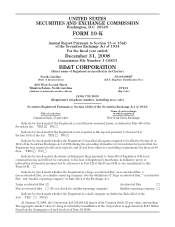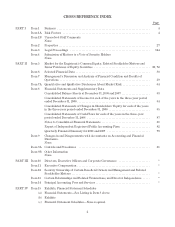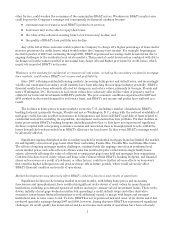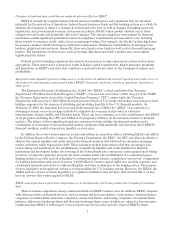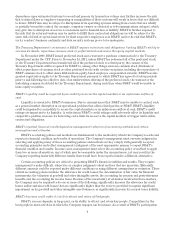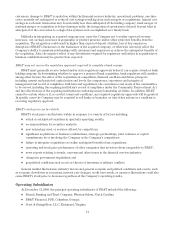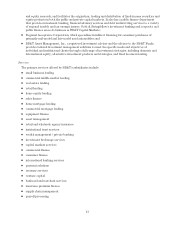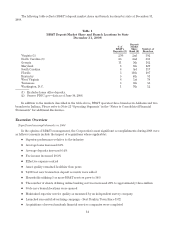BB&T 2008 Annual Report Download - page 7
Download and view the complete annual report
Please find page 7 of the 2008 BB&T annual report below. You can navigate through the pages in the report by either clicking on the pages listed below, or by using the keyword search tool below to find specific information within the annual report.Changes in banking laws could have a material adverse effect on BB&T.
BB&T is extensively regulated under federal and state banking laws and regulations that are intended
primarily for the protection of depositors, federal deposit insurance funds and the banking system as a whole. In
addition, the Company is subject to changes in federal and state laws as well as changes in banking and credit
regulations, and governmental economic and monetary policies. BB&T cannot predict whether any of these
changes may adversely and materially affect the Company. The current regulatory environment for financial
institutions entails significant potential increases in compliance requirements and associated costs, including
those related to consumer credit, with a focus on mortgage lending. For example, the North Carolina legislature
has passed a number of bills that impose additional requirements, limitations and liabilities on mortgage loan
brokers, originators and servicers. Generally, these enactments cover banks as well as state-licensed mortgage
lenders. The legislatures of other states, such as Georgia, Maryland and South Carolina, may enact similar
legislation in the future.
Federal and state banking regulators also possess broad powers to take supervisory actions as they deem
appropriate. These supervisory actions may result in higher capital requirements, higher insurance premiums
and limitations on BB&T’s activities that could have a material adverse effect on the Company’s business and
profitability.
Legislative and regulatory actions taken now or in the future to address the current liquidity and credit crisis in
the financial industry may significantly affect BB&T’s financial condition, results of operation, liquidity or
stock price.
The Emergency Economic Stabilization Act of 2008 (the “EESA”), which established the Treasury
Department’s Troubled Asset Relief Program (“TARP”), was enacted on October 3, 2008. As part of the TARP,
the Treasury Department created the Capital Purchase Program (“CPP”), under which the Treasury
Department will invest up to $250 billion in senior preferred stock of U.S. banks and savings associations or their
holding companies for the purpose of stabilizing and providing liquidity to the U.S. financial markets. On
February 17, 2009, the American Recovery and Reinvestment Act of 2009 (the “ARRA”) was enacted as a
sweeping economic recovery package intended to stimulate the economy and provide for extensive
infrastructure, energy, health, and education needs. There can be no assurance as to the actual impact that EESA
or its programs, including the CPP, and ARRA or its programs, will have on the national economy or financial
markets. The failure of these significant legislative measures to help stabilize the financial markets and a
continuation or worsening of current financial market conditions could materially and adversely affect BB&T’s
financial condition, results of operation, liquidity or stock price.
In addition, there have been numerous actions undertaken in connection with or following EESA and ARRA
by the Federal Reserve Board, Congress, the Treasury Department, the FDIC, the SEC and others in efforts to
address the current liquidity and credit crisis in the financial industry that followed the sub-prime mortgage
market meltdown which began in late 2007. These measures include homeowner relief that encourages loan
restructuring and modification; the establishment of significant liquidity and credit facilities for financial
institutions and investment banks; the lowering of the federal funds rate; emergency action against short selling
practices; a temporary guaranty program for money market funds; the establishment of a commercial paper
funding facility to provide back-stop liquidity to commercial paper issuers; a mandatory “stress test” requirement
for banking institutions with assets in excess of $100 billion to analyze capital sufficiency and risk exposure; and
coordinated international efforts to address illiquidity and other weaknesses in the banking sector. The purpose
of these legislative and regulatory actions is to help stabilize the U.S. banking system. However, the EESA, the
ARRA and any current or future legislative or regulatory initiatives may not have their desired effect, or may
have an adverse effect when applied to BB&T.
BB&T may experience significant competition in its market area, which may reduce the Company’s customer
base.
There is intense competition among commercial banks in BB&T’s market area. In addition, BB&T competes
with other providers of financial services, such as savings and loan associations, credit unions, consumer finance
companies, securities firms, insurance companies, commercial finance and leasing companies, the mutual funds
industry, full-service brokerage firms and discount brokerage firms, some of which are subject to less extensive
regulations than BB&T is with respect to the products and services they provide. Some of BB&T’s larger
7

